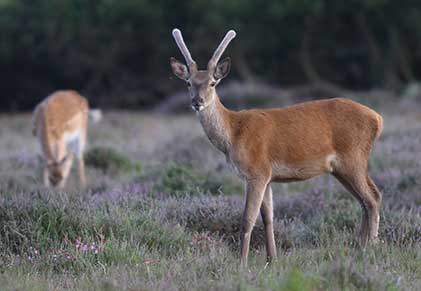New Forest deer: obtain closer views - some general principles
Here are some general principles for obtaining close views of New Forest deer.

but the nearby fallow doe continues to feed
Identify your quarry
Do you particularly want on a visit to the New Forest to see fallow deer, red deer, roe deer or sika deer? Or do you prefer to see the relatively widespread but generally elusive muntjac deer?
Each species, you see, is likely to be present in subtly different places, and to have varied habits that need to be identified and reflected if stalking is to be consistently successful.
Consider starting with the more confiding species
Red deer and sika deer in the New Forest are likely to allow a closer approach than fallow deer and roe deer.
Get to know the terrain and the local deers' habitats
The best opportunities for consistently obtaining good, close views of wild deer are likely to be in places where both the terrain and the local deer are known, places where the watcher is familiar with the deer’s habits, their favourite pathways, lying-up places, feeding and rutting grounds. Take the time, then, for reconnaissance, or accept that early visits are likely to be by default, reconnaissance visits.
Work alone
Working alone has much to commend it. Whilst a little unsociable, working alone significantly increases the chances of success when stalking deer, for the probability of detection increases significantly when two or more people are involved. For example, with companions, there is at least double the likelihood of a twig cracking underfoot, of disturbed leaves rustling noisily, and of movement alerting the quarry. There’s also always the temptation to talk, a sure way of alerting every deer in the vicinity to the threat of danger.
Never take a dog, however placid and well-behaved your pet may be
It’s difficult to combine serious deer watching with dog walking. For obvious reasons, the two do not go well together.
Avoid the urge to hurry
Relax: don’t rush, for haste is the enemy of those requiring good, close views of deer.
Consider letting the deer come to you
Identify a likely deer watching place, then sit down and wait. If you’re quiet, still, blend in with the background and avoid breezes that will betray your presence, it’s surprising just how close some deer will approach.
Always be alert, concentrate, and be ever watchful
Look out for every slightest sign of deer, even in thick vegetation - their general outline, the sweep of the neck, the shape of the back, and the flick of ears or tail. And listen constantly for deer sounds that might reveal presence - rustles in the undergrowth as deer move away; sharp, cough-like barks normally given by disturbed deer; high pitched squeaking of youngsters; roaring, groaning and whistling of rutting stags and bucks; and the sound of bone striking bone as these animals do battle.
Look out for deer field signs
Field signs help build a picture of the deer’s movements and likely whereabouts – try to spot slots in the mud, droppings, scrapes and wallows, thrashed branches, saplings stripped of bark, disturbed leaves and roe rings.
Be aware of the dangers associated with occasionally aggressive deer
Although most deer are primarily concerned with taking evasive action when disturbed, a tiny minority may behave aggressively – roe bucks during the rut, for example, have a particular reputation for belligerence. Take notice of the deer’s mood and be particularly wary if stags or bucks stand their ground, move forward or show other signs of aggression towards observers.
New Forest deer - obtain closer views
New Forest deer - find out lots more
References:
The History of British Mammals: Derek Yalden
Roe Deer: John K. Fawcett, British Deer Society
New Forest Roe Deer: John K. Fawcett
Deer Watch: Richard Prior
Mammals of Britain and Europe: David McDonald, Priscilla Barret
Field Guide to British Deer: F J Taylor Page
More links
Other related links
Search this site

Sadly, 58 animals were killed - 35 ponies, 13 cows, 8 donkeys and 2 sheep, whilst a further 32 were injured - 3 pigs, 9 donkeys, 11 cows and 9 ponies.
(Forty-three accidents occurred in daylight, 15 at twilight and 101 in the dark. Twenty-seven accidents were not reported by the driver involved).
Here's just one horrific example - Three donkeys killed in collision with van at notorious New Forest blackspot (Advertiser and Times)

